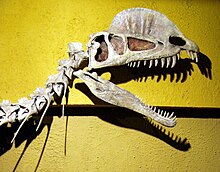Description[edit]
Dilophosaurus measured around 7 metres (23 ft) long and may have weighed 500 kilograms (1,100 lb).[1]
The teeth of Dilophosaurus are long, but have a fairly small base and expand basally.[2] Dilophosaurus had 12 maxillary teeth and as many as 18 dentary teeth; the teeth were smaller in the tip of the upper jaw. The second and third front teeth feature serrations, which are absent in the fourth.[3] Another skull feature was a notch behind the first row of teeth, givingDilophosaurus an almost crocodile-like appearance, similar to the putatively piscivorous spinosaurid dinosaurs. This "notch" existed by virtue of a weak connection between thepremaxillary and maxillary bones of the skull.[4] The braincase is well known in Dilophosaurus, and is significant in that it bears a feature of the top side wall that is absent inceratosaurians.[3] Compared with ceratosaurians, the distal scapular expansion in D. wetherilli is uniquely rectangular.[3] The upper leg bone (femur) is longer than the lower leg (tibia).[3]
A study by Gay (2005) comparing various specimens found no indication that sexual dimorphism was present in Dilophosaurus, so males and females would have been largely the same in terms of skeletal anatomy.[5]
Cranial ornamentation[edit]
The most distinctive characteristic of Dilophosaurus is the pair of rounded crests on its skull, made up of extensions of the nasal and lacrimal bones. These are considered to be too delicate for anything but display purposes.[3][6] Dodson (1997) noted that cranial crests first appeared in Dilophosaurus and were later retained, in one form or another, by other theropods.[7]
The function of the crests on the skull of Dilophosaurus have been the subject of speculation among scientists ever since they were discovered. Traditionally, these bizarre cranial structures (and similar structures and post-cranial armor in other dinosaurs) were thought to be variously for attracting mates, intimidating/fighting rivals in the group, and intimidating potential predators of other species. However, Padian, Horner and Dhaliwal (2004) argued that phylogenetic, histological, and functional evidence indicates that these bizarre structures were most likely used for intra-species recognition.[8][9]
Classification[edit]
|
Dilophosaurus has been examined several times over the years and has been assigned to no less than nine different theropod groups. Welles (1954) and the majority of subsequent phylogenetic analyses during the 1980s and 1990s have classified this genus as a large coelophysoid within the taxon Coelophysoidea.[6][11] However, some more recent studies have provided varying degrees of support for Dilophosaurus and various other "dilophosaurids" being more closely related to tetanuran theropods than to true coelophysoids.[12][13] Smith (2007) considered the genus Cryolophosaurus as the closest known relative of Dilophosaurus.[14]
Distinguishing anatomical features[edit]
A diagnosis is a statement of the anatomical features of an organism (or group) that collectively distinguish it from all other organisms. Some, but not all, of the features in a diagnosis are also autapomorphies. An autapomorphy is a distinctive anatomical feature that is unique to a given organism or group.
According to Rauhut (2000), Dilophosaurus can be distinguished based on the following features:[3][15]
- a lacrimal bone with a thickened dorso-posterior rim
- cervical vertebrae that have neural spines with a distinct central "cap" and an anterior and posterior "shoulder"
- a scapular blade with a squared distal expansion
- the presence of thin, paired nasolacrimal crests extending vertically from skull roof, each with a fingerlike posterior projection (according to Carrano, 2012)[16]




No comments:
Post a Comment